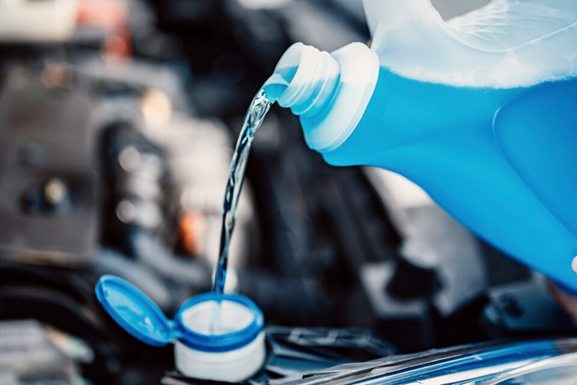
When we think about pollutants spewed from our daily commute, exhaust fumes tend to be the first thing that springs to mind. But a startling new study from the American Chemical Society (American Chemical Society (acs.org) challenges this assumption, spotlighting an underappreciated source of vehicular emissions: windshield washer fluid.
This study suggests that windshield washer fluid’s alcoholic content contributes significantly more to real-world vehicle emissions (Carbon emissions from fertilizers could be cut by 80 percent • Earth.com) than previously thought. The researchers argue that even as more and more drivers switch from gasoline to electric vehicles, the emission levels of these non-fuel-derived gases will likely remain consistent.
Over the past two decades, average carbon dioxide emissions from cars have seen a marked decrease. A report from the U.S. Environmental Protection Agency indicates a 25 percent drop since the early 2000s. However, carbon dioxide is merely one component of the emissions problem.
The villainous roster of pollutants also includes volatile organic compounds (VOCs). VOCs, a category of carbon-based molecules that easily vaporize, contribute significantly to ozone formation. Although exhaust gases emit some VOCs, car-care products, including windshield washer fluid, are another significant source.
Existing estimates from a comprehensive inventory of manufacturer statistics in the U.K. indicate that these car-care products may be a more substantial source of VOCs than exhaust. Yet, until now, no experimental verification existed.
Samuel Cliff and his team decided to fill this gap by measuring the vaporized windshield washer fluid ingredients emitted by cars on real-world roads, comparing these figures to the existing inventory estimates.
The team, equipped with several instruments including a mass spectrometer, stationed a van near a busy roadway to record the VOCs released by passing vehicles. They compared these readings to measurements taken at a university site with minimal traffic to calculate the average amount of vapor emitted per car for each kilometer traveled for key VOCs.
Their observations painted a fascinating picture. The measurements for aromatic compounds, which are commonly monitored and regulated, matched the inventory estimates.
However, the alcohol readings, critical components in windshield washer fluid, surpassed the inventory figures. The released amounts of two alcohols, ethanol and methanol, were almost double that of all VOCs emitted through exhaust.
This stark discrepancy in alcohol emissions suggested that including solvents from car-care products in inventory estimations could lead to a more accurate assessment of vehicle-derived pollutants. This would, therefore, indicate that these products are a significant, if overlooked, source of vehicular pollutants.
This revelation has profound implications for future regulatory policy. Electric vehicles might emit fewer fuel-derived pollutants, but windshield washing is an unavoidable part of vehicle maintenance. Therefore, car care products’ emissions will persist, demanding attention and suitable regulatory measures.
The study, which is published in the journal Environmental Science & Technology ( Unreported VOC Emissions from Road Transport Including from Electric Vehicles | Environmental Science & Technology (acs.org), received funding from the U.K. Natural Environment Research Council and the Panorama Natural Environment Research Council Doctoral Training Partnership.
More about windshield wiper fluid
Windshield wiper fluid, also known as windshield washer fluid or wiper fluid, is a liquid used in conjunction with the wiper blades of a vehicle to clean the windshield. This fluid helps to remove dirt, insects, bird droppings, and other debris that may accumulate on a windshield during travel.
The fluid’s primary components include water, alcohol such as methanol, ethylene glycol, or ethanol, and detergents. Some variations may also include antifreeze components for use in cold climates, where it’s important that the fluid doesn’t freeze upon contact with the windshield or within the reservoir of the vehicle.
The alcohol content in windshield washer fluid serves as both a cleaning agent and an antifreeze agent. Methanol and ethanol help to break down grime and dirt while preventing the fluid from freezing in cold conditions.
Use caution with wiper fluid
Despite its usefulness, it’s important to handle windshield wiper fluid carefully. For instance, methanol, a common ingredient, is considered toxic and can be harmful or fatal if ingested. It can also irritate the skin and eyes, which is why it’s recommended to use caution when filling up your car’s wiper fluid reservoir.
As highlighted by the study in your previous question, windshield wiper fluid can also contribute to environmental pollution. When used, the alcohol and other volatile organic compounds in the fluid can evaporate into the atmosphere, contributing to air pollution.
Lastly, given its potential environmental impact, some manufacturers are now producing “eco-friendly” windshield washer fluids. These use plant-derived ingredients and avoid harmful substances like methanol. While they may not always be as effective in extreme weather conditions, they provide a more sustainable option for drivers concerned about their environmental footprint.
About the ACS
The American Chemical Society (ACS) is a nonprofit organization chartered by the U.S. Congress. ACS’ mission is to advance the broader chemistry enterprise and its practitioners for the benefit of Earth and all its people. The Society is a global leader in promoting excellence in science education and providing access to chemistry-related information and research through its multiple research solutions, peer-reviewed journals, scientific conferences, eBooks and weekly news periodical Chemical & Engineering News.
ACS journals are among the most cited, most trusted and most read within the scientific literature; however, ACS itself does not conduct chemical research. As a leader in scientific information solutions, its CAS division partners with global innovators to accelerate breakthroughs by curating, connecting and analyzing the world’s scientific knowledge. ACS’ main offices are in Washington, D.C., and Columbus, Ohio.
Source: Earth.com
May 31, 2023


